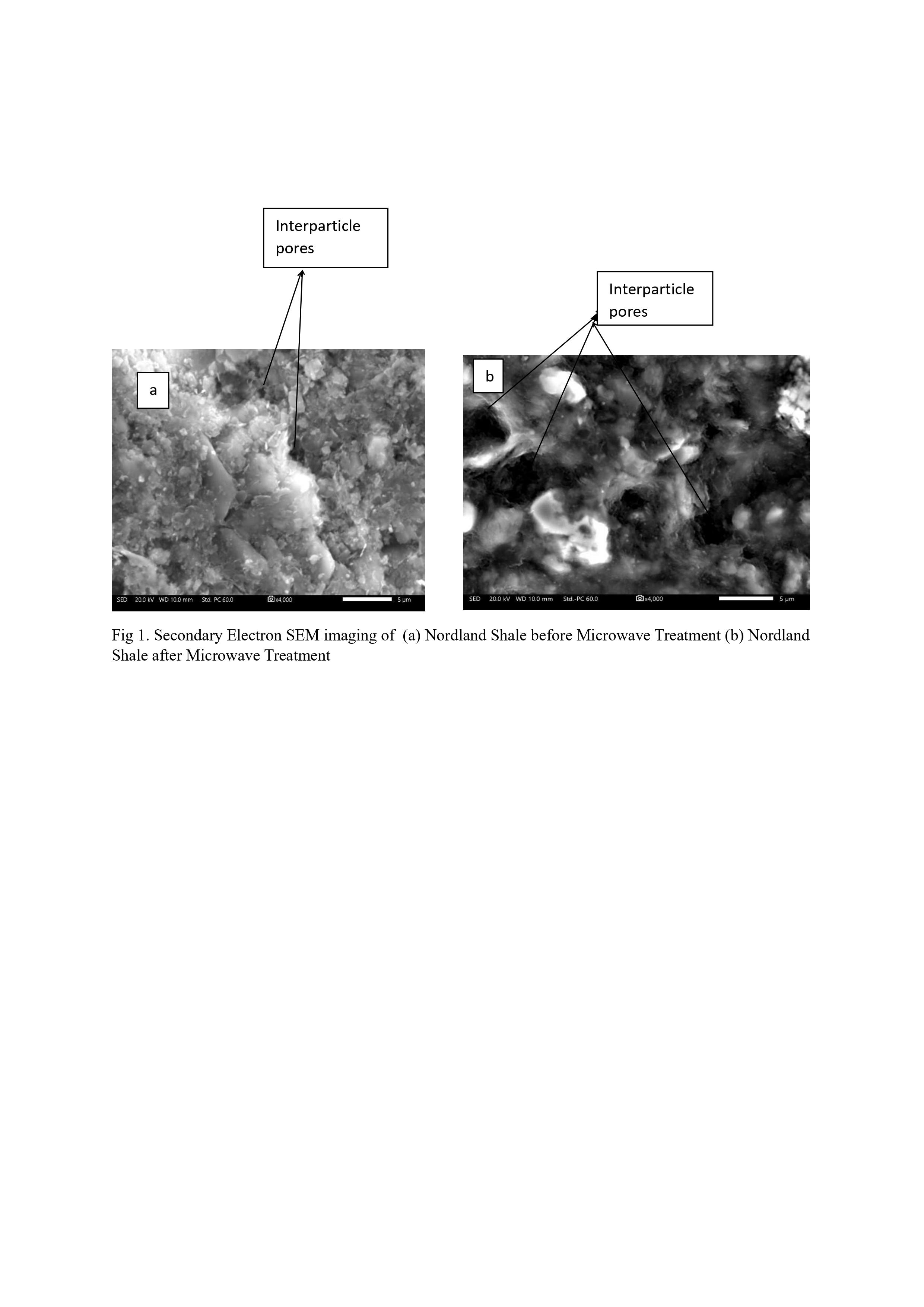Background
Use of carbon dioxide to displace methane from shale gas reservoirs offers the potential to both enhance gas production but also simultaneously sequester carbon [1]. The process of fracking opens up the previously tight shale pore structure to admit the carbon dioxide to enable displacement of the methane. Microwaves represent a key, efficient technology for fracking the shale rock that offers the potential for better control of the process. However, the exact impact of the microwaves on the pore structure, transport and mineralogy properties of the shale remains uncertain. Further, shales present an ongoing challenge to comprehensive pore structure characterisation due to their complexity [2], as they possess structural and chemical heterogeneities over many length-scales, that all evolve under microwave treatment.
Method
In this work, different shale lithofacies (e.g. Nordland, Utica, and Marcellus) with different ages and levels of thermal maturity, including caprock and reservoir rock types, have been treated with microwaves under a range of conditions (e.g. power, time), and the impact of that treatment on pore structure, transport properties, and mineralogy has been studied. The Nordland, Utica and Marcellus shales studied date from the upper Pliocene, upper Ordovician and middle Devonian, respectively. The Nordland shale is a caprock which has a base ~800 m below sea level. The Utica and Marcellus shales are reservoir rocks.
The pore structural techniques used to study the evolution of the void space are relatively novel, and rarely used for looking at shale and other rocks. The pore structure characterisation has employed the gas overcondensation technique to enable very large macropores to be studied, within the same experiment, in conjunction with the micropores and mesopores typically probed in conventional adsorption experiments [2,3]. This enables the relative juxtaposition and connectivity of pores from a very wide range of size scales to be studied within one technique.
The integrated gas sorption and mercury porosimetry method obtains nitrogen sorption isotherms and rate of adsorption data for both before and after mercury entrapment in a series of experiments conducted on the same sample. This experiment is a means to implement the so-called ‘sifting strategy’ [2] that attempts to identify the key aspects of the void space that control mass transfer without the need for a ‘brute force’ approach. The latter requires multi-modal imaging and extensive data management. With the brute force approach, it is often necessary to reduce the raw image data-sets to make mass transport calculations for properly representative volumes tractable with current computing power, often by deriving pore network models. However, it is not possible to know in advance how much information can be dispensed with and still maintain a predictive model. In contrast, the sifting strategy systematically removes different sub-sets of the void space to directly test their variable contribution(s) to mass transport. This can be used to check if the key determining factor for mass transport has been altered due to microwave treatment.
Result
Gas overcondensation, coupled with scanning, has enabled the changes in pore connectivity amongst, and between, the different levels of the porosity to be measured. Simultaneous adsorption and calorimetry experiments have enabled changes in adsorption strength and capacity for carbon dioxide to be correlated with structural changes induced by microwaves, along with the changes to mass uptake properties. Detailed electron microscopy studies have assessed the mineralogical changes, especially mineral grain annealing and illite-smectite clay transformations.
A percolation analysis of the overcondensation data for the Sleipner caprock, Nordland shale, before and after relatively mild (600W, 16s) microwave treatment has been conducted. It was found that microwave treatment leads to there being a greater impact on the mass transfer coefficient, resulting from the removal of a similar percentage of pore volume, consisting of the very largest pore sizes, through mercury entrapment, than for untreated shale. The relative accessibility of the smaller mesopores has been changed by the microwaves, leading to a different impact on structure and mass transport from the loss of larger pores. Studies on more intensively treated Nordland samples (dry, 600 W, 50 s) led to more substantial changes in the void space, with a significant loss of pore volume, as compared to a small growth with lower intensity treatment, and a large relative increase in the general accessibility of the whole void space.
A detailed analysis of the sorption hysteresis obtained via overcondensation experiments has shown the changes to the pore structure in Utica shale. The changes to gas sorption ascending scanning loop data have been used to study changes in the pore network accessibility with microwaving.
Implications
The pore characterization methods used enable changes engendered in the void space by the microwave treatment, not obvious from other techniques, to be quantitatively assessed in a more statistically representative manner than possible with multi-modal imaging. This will enable the changes to producibility of reservoir rocks, or the leakage potential of caprocks, to be better understood.
References:
1.Spanakos, D.; Rigby, S.P. Fuel, 307 (2022) 121928
2. Rigby, S.P. Structural Characterisation of Natural and Industrial Porous Materials: A Manual, Springer International Publishing: Cham, 2020.
3. Rouquerol, F.; Rouquerol, J.; Sing, K. Adsorption by Powders and Porous Solids: Principles, Methodology and Applications; Academic Press: London, 1999.
Acknowledgements:
The authors thank the PTDF, Nigeria, for funding this research.


